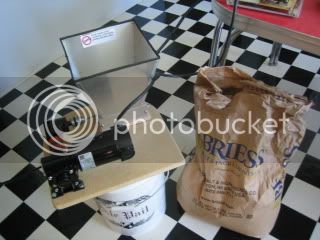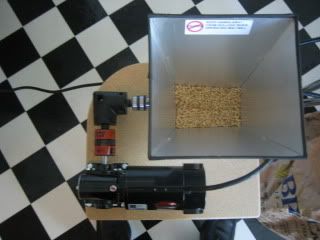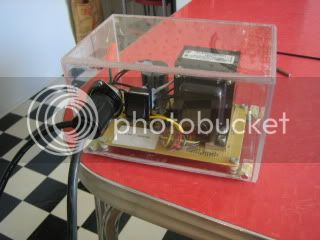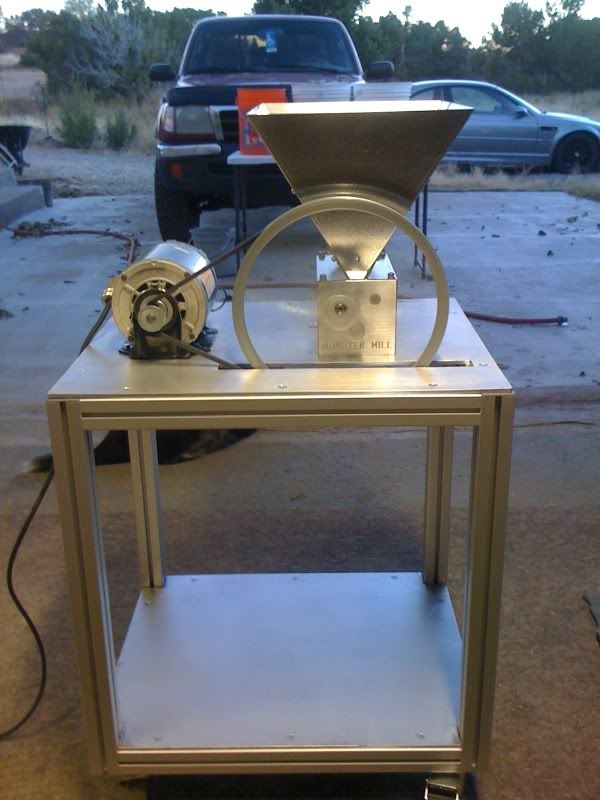Nice Perogi! It is good to see a build with protection around the belts and pulleys, proper bearings on the shafts, and a sluice valve on the grain feed too. Well done.
You are using an out of date browser. It may not display this or other websites correctly.
You should upgrade or use an alternative browser.
You should upgrade or use an alternative browser.
Motorized Grain Mills: Time to show them off!
- Thread starter SAMPLER
- Start date

Help Support Homebrew Talk:
This site may earn a commission from merchant affiliate
links, including eBay, Amazon, and others.
Huaco
Well-Known Member
Hey Perogi... I've seen that mill somewhere else... ;-)
Ha Huaco!!
mrklueber - Let me piece together the parts (pun intended) and start a new thread. I will add the link here.
Thanks reynolds5520!
Link: https://www.homebrewtalk.com/f51/porter-milton-grain-mill-400251/#post5040299
mrklueber - Let me piece together the parts (pun intended) and start a new thread. I will add the link here.
Thanks reynolds5520!
Link: https://www.homebrewtalk.com/f51/porter-milton-grain-mill-400251/#post5040299
MaltedBayerl
Well-Known Member
Here's my $0.00 Pasta Maker Grain Mill in action.:fro:
http://www.youtube.com/watch?v=PXJ4OCCY_I4&feature=youtu.be
I used the "drill bit in reverse" technique to "knurl" my rollers and it seems to be doing a pretty good job so far. I've milled at least 25lbs of grain with it. I found a large, old flathead screwdriver that fit in the slot for the crank and I just sawed off the tip to mount in the drill. I could hand crank it but that got old after a few pounds of grain. I added the upper hopper/plastic bottle holder part after a couple batches. It probably holds 2 or 3 lbs of grain at a time. For costing nothing, I'll use it until it breaks. :rockin:
I had some trouble keeping it going and stable on the table while holding the camera in the video. I have to keep the drill farther inside too, I've learned. Once it gets going, I try not to stop. Having someone to pour in grain helps. Wheat is tough to get going so I "prime" it with some barley to get it rolling.
http://www.youtube.com/watch?v=PXJ4OCCY_I4&feature=youtu.be
I used the "drill bit in reverse" technique to "knurl" my rollers and it seems to be doing a pretty good job so far. I've milled at least 25lbs of grain with it. I found a large, old flathead screwdriver that fit in the slot for the crank and I just sawed off the tip to mount in the drill. I could hand crank it but that got old after a few pounds of grain. I added the upper hopper/plastic bottle holder part after a couple batches. It probably holds 2 or 3 lbs of grain at a time. For costing nothing, I'll use it until it breaks. :rockin:
I had some trouble keeping it going and stable on the table while holding the camera in the video. I have to keep the drill farther inside too, I've learned. Once it gets going, I try not to stop. Having someone to pour in grain helps. Wheat is tough to get going so I "prime" it with some barley to get it rolling.
I'm looking to get my MM-3 going and naturally want to save some dollars so took stock of what I have. I have an old lathe with a GE 3/4hp motor, 1725 rpm. It says with its 2" motor pulley and 4.5" spindle pulley it has 635 rpm. I also have a shaft and pillow blocks so can put another pulley off that to slow it down further. But I'm curious how important it is for reverse - I've seen that referred to ofter in this thread. This motor just has two wires out of it.
Another motor I have is from a blower. It is a Lennox 1/3 hp, 1025 rmp, 6 amp motor that can be 110V or 220V. It has several wires but I assume it isn't reversible either? A couple purple wires go to a capacitor, a white common, a black for Hi speed, Brown for med. hi, yellow for med. low, and red for low. I could gear this down with pulleys too.. if it were powerful enough. So any thoughts? and is it important for reverse? Looks like to buy a motor now-a-days and gearing it down or buying a geared motor is lots more expensive than it was a couple years ago.
cheers, JD
Another motor I have is from a blower. It is a Lennox 1/3 hp, 1025 rmp, 6 amp motor that can be 110V or 220V. It has several wires but I assume it isn't reversible either? A couple purple wires go to a capacitor, a white common, a black for Hi speed, Brown for med. hi, yellow for med. low, and red for low. I could gear this down with pulleys too.. if it were powerful enough. So any thoughts? and is it important for reverse? Looks like to buy a motor now-a-days and gearing it down or buying a geared motor is lots more expensive than it was a couple years ago.
cheers, JD

$7.79 ($7.79 / Count)
Craft A Brew - LalBrew Voss™ - Kveik Ale Yeast - For Craft Lagers - Ingredients for Home Brewing - Beer Making Supplies - (1 Pack)
Craft a Brew

$22.00 ($623.23 / Ounce)
AMZLMPKNTW Ball Lock Sample Faucet 30cm Reinforced Silicone Hose Secondary Fermentation Homebrew Kegging joyful
无为中南商贸有限公司

$33.99 ($17.00 / Count)
$41.99 ($21.00 / Count)
2 Pack 1 Gallon Large Fermentation Jars with 3 Airlocks and 2 SCREW Lids(100% Airtight Heavy Duty Lid w Silicone) - Wide Mouth Glass Jars w Scale Mark - Pickle Jars for Sauerkraut, Sourdough Starter
Qianfenie Direct

$53.24
1pc Hose Barb/MFL 1.5" Tri Clamp to Ball Lock Post Liquid Gas Homebrew Kegging Fermentation Parts Brewer Hardware SUS304(Liquid Hose Barb)
yunchengshiyanhuqucuichendianzishangwuyouxiangongsi

$479.00
$559.00
EdgeStar KC1000SS Craft Brew Kegerator for 1/6 Barrel and Cornelius Kegs
Amazon.com

$53.24
1pc Hose Barb/MFL 1.5" Tri Clamp to Ball Lock Post Liquid Gas Homebrew Kegging Fermentation Parts Brewer Hardware SUS304(Liquid Hose Barb)
Guangshui Weilu You Trading Co., Ltd

$20.94
$29.99
The Brew Your Own Big Book of Clone Recipes: Featuring 300 Homebrew Recipes from Your Favorite Breweries
Amazon.com

$719.00
$799.00
EdgeStar KC2000TWIN Full Size Dual Tap Kegerator & Draft Beer Dispenser - Black
Amazon.com

$10.99 ($31.16 / Ounce)
Hornindal Kveik Yeast for Homebrewing - Mead, Cider, Wine, Beer - 10g Packet - Saccharomyces Cerevisiae - Sold by Shadowhive.com
Shadowhive

$176.97
1pc Commercial Keg Manifold 2" Tri Clamp,Ball Lock Tapping Head,Pressure Gauge/Adjustable PRV for Kegging,Fermentation Control
hanhanbaihuoxiaoshoudian

$58.16
HUIZHUGS Brewing Equipment Keg Ball Lock Faucet 30cm Reinforced Silicone Hose Secondary Fermentation Homebrew Kegging Brewing Equipment
xiangshuizhenzhanglingfengshop
- Joined
- Mar 2, 2011
- Messages
- 414
- Reaction score
- 57
Hunky, I did something similar to what you are thinking about in post #147. Mine is made from scrap wood and since I still use my lathe, the mill removable.
Hunky said:I'm looking to get my MM-3 going and naturally want to save some dollars so took stock of what I have. I have an old lathe with a GE 3/4hp motor, 1725 rpm. It says with its 2" motor pulley and 4.5" spindle pulley it has 635 rpm. I also have a shaft and pillow blocks so can put another pulley off that to slow it down further. But I'm curious how important it is for reverse - I've seen that referred to ofter in this thread. This motor just has two wires out of it.
Another motor I have is from a blower. It is a Lennox 1/3 hp, 1025 rmp, 6 amp motor that can be 110V or 220V. It has several wires but I assume it isn't reversible either? A couple purple wires go to a capacitor, a white common, a black for Hi speed, Brown for med. hi, yellow for med. low, and red for low. I could gear this down with pulleys too.. if it were powerful enough. So any thoughts? and is it important for reverse? Looks like to buy a motor now-a-days and gearing it down or buying a geared motor is lots more expensive than it was a couple years ago.
cheers, JD
Switching the #5 lead with the #8 lead will reverse your dual voltage motor
flushdrew42
Well-Known Member
A buddy of mine and i just went "dutch" on the purchase of a Barley Crusher. He's a new brewer, in fact hasn't brewed a drop yet, just collecting all of his equipment. Anyway, the being "part" owners of the crusher we decided to make it portable. After several homebrews and several design ideas, we came across a "david" sunflower seeds bucket from sam's club. it fit the crusher and hopper nearly perfectly, so here's what we came up with for our
"PBC: Portable Barley Crusher"
In the next post, I will show how we tackled the "ridges" in the bottom of the bucket, and how we made an extension for the shaft, with a set screw collar.





"PBC: Portable Barley Crusher"
In the next post, I will show how we tackled the "ridges" in the bottom of the bucket, and how we made an extension for the shaft, with a set screw collar.





flushdrew42
Well-Known Member
the bottom of the buckets have ridges in them, and so wood was cut to fill them in flat, so the mill could be firmly mounted to the bucket. the lid to the bucket bottom, and then the crushed grains fall into the bottom bucket.
we also had a buddy that works for a machine shop make us an extension collar for the shaft on the crusher. paid him in a few beverages, and he made it out of scrap round stainless stock.




we also had a buddy that works for a machine shop make us an extension collar for the shaft on the crusher. paid him in a few beverages, and he made it out of scrap round stainless stock.




Transamguy77
Well-Known Member
I've got a couple 1/2" electric drills in stock and a speed reducer coming so will give that a shot until I rig up something a bit better.
I'm curious what kind of forces would be on a 12" sheave (pulley). I'm thinking I could build one out of 3/4" plywood since buying one seems to be in the neighborhood of $37 plus about $30 in shipping (I'm rural Alaska). My lathe motor is 1725 rpm and has a 2" pulley as smallest diameter on a cluster of larger pulleys.
/jd
I'm curious what kind of forces would be on a 12" sheave (pulley). I'm thinking I could build one out of 3/4" plywood since buying one seems to be in the neighborhood of $37 plus about $30 in shipping (I'm rural Alaska). My lathe motor is 1725 rpm and has a 2" pulley as smallest diameter on a cluster of larger pulleys.
/jd
jeepinjeepin
Well-Known Member
Hunky said:I've got a couple 1/2" electric drills in stock and a speed reducer coming so will give that a shot until I rig up something a bit better.
I'm curious what kind of forces would be on a 12" sheave (pulley). I'm thinking I could build one out of 3/4" plywood since buying one seems to be in the neighborhood of $37 plus about $30 in shipping (I'm rural Alaska). My lathe motor is 1725 rpm and has a 2" pulley as smallest diameter on a cluster of larger pulleys.
/jd
3/4" plywood should be more than sufficient. Just use common sense when putting it together. Use wide bases and box it off the make it stiff in all directions.
BaldApe
Well-Known Member
I have a motor from a grinding wheel my Dad used. It is a 1/4 HP type KH motor rated at 1745 RPM.
I bought two pulleys, a 2 inch and an 11 inch, but I'm worried that the speed reduction won't be enough for my Corona mill to handle.
Can I use a dimmer switch to slow the motor, or will that burn it out?
I bought two pulleys, a 2 inch and an 11 inch, but I'm worried that the speed reduction won't be enough for my Corona mill to handle.
Can I use a dimmer switch to slow the motor, or will that burn it out?
g-love
Well-Known Member
Just finished mine today. I have to say that it took me an embarrassingly long time to get the motor leveled and squared up to the mill itself. What a PITA.... :cross:
Anyway, I haven't run any grain through it yet, but I'm anticipating good things.
I basically stole jpalarchio's design. I like the idea of it being portable and easily hung on a wall, rather than taking up floor space. Thanks J!


Anyway, I haven't run any grain through it yet, but I'm anticipating good things.
I basically stole jpalarchio's design. I like the idea of it being portable and easily hung on a wall, rather than taking up floor space. Thanks J!


lpdjshaw
Well-Known Member
Bodine gearmotor off e-bay, DC, converted to AC. A lovejoy and a right-angle attachment for a power drill - sits on the bucket, goes anywhere, doesn't take up much space. The rpm is low, torque is high, bet it would crush rocks.


the DC to AC converter box I built (with a little help from an electronics forum)

Wow! Gotta mark this one for when I get ready to motorize my mill. Love the very small footprint.
lpdjshaw
Well-Known Member
Here's mine:
After some help from DayTripper and inspiration from ClarnoBrewer I just got finished motorizing my AWESOME Rebel Brewer Mill. This thing is built like a tank and now thats it's powered it has no problem crushing grain!
Thanks to all who have provided me with inspiration and guidance!!
Sweet idea!!!
Here's a old pic of mine.


g-love
Well-Known Member
Here's a old pic of mine.
Ooooooh. Shiny!
Here's a old pic of mine.
Nice build!
Is that a clapped-out M in the background?
Cheers!
Here's a old pic of mine.

How do you adjust the tension on your belt with the motor mounted that way? How was thinking about a similar set up.
The motor I have has slotted mounting holes in its base bracket. I merely tapped an appropriate bolt pattern in the top plate and I tighten the bolts accordingly once I've snugged up the belt. I've been using it for about 2 years now and it hasn't slipped once. I only had to adjust the tension once after removing the mill for maintenance and re-gapping my rollers.
Nice build!
Is that a clapped-out M in the background?
Cheers!
Yessir. That was my old track car:

jeepinjeepin
Well-Known Member
dcbw said:Used an old 1/2HP 1725 RPM motor that came from a planer in my grandfather's wood shop. I used to use a high-torque low-speed D-handle drill from Menards but that bogged down too often even with a 0.45 gap. I don't have that problem anymore.
Correct me if my thinking is wrong, but for easy math say you have a 1" pulley on the motor and a 10" pulley on the mill is the 1/2hp motor exerting 5hp at the mill? That would explain the difference.
Correct me if my thinking is wrong, but for easy math say you have a 1" pulley on the motor and a 10" pulley on the mill is the 1/2hp motor exerting 5hp at the mill? That would explain the difference.
Actually 1.5" on the motor and 12" on the mill to get RPM down to about 200-something. But it was also hard to keep the drill speed consistently low enough to mill well but high enough not to bind, and since I had the 1/2 HP motor I was like "how hard can it be?" Turns out it wasn't that hard...
jeepinjeepin
Well-Known Member
dcbw said:Actually 1.5" on the motor and 12" on the mill to get RPM down to about 200-something. But it was also hard to keep the drill speed consistently low enough to mill well but high enough not to bind, and since I had the 1/2 HP motor I was like "how hard can it be?" Turns out it wasn't that hard...
So that's an 8x reduction in speed. Is it also an 8x increase in torque? The motor is now inputting 4hp? Honest question.
Correct me if my thinking is wrong, but for easy math say you have a 1" pulley on the motor and a 10" pulley on the mill is the 1/2hp motor exerting 5hp at the mill? That would explain the difference.
The hp stays the same, only the torque increases.
jeepinjeepin
Well-Known Member
ChuckO said:The hp stays the same, only the torque increases.
That's right. Thanks!
Similar threads
- Replies
- 0
- Views
- 328
- Replies
- 7
- Views
- 836






































![Craft A Brew - Safale BE-256 Yeast - Fermentis - Belgian Ale Dry Yeast - For Belgian & Strong Ales - Ingredients for Home Brewing - Beer Making Supplies - [3 Pack]](https://m.media-amazon.com/images/I/51bcKEwQmWL._SL500_.jpg)














